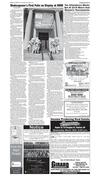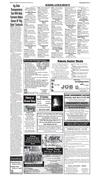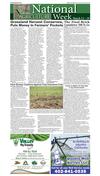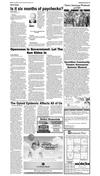10
National
10 Broadcaster Press
March 15, 2016 www.broadcasteronline.com
Week March 13 ~ 19
Grassland Harvest Conserves, The Final Brick
Puts Money In Farmers' Pockets Countdown: 500 To Go
The USDA's Farm Service
Agency established the
Conservation Reserve Program
(CRP) 30 years ago in an effort
to improve water quality, reduce
soil erosion, and increase habitat
for sensitive wildlife species. The
program pays rent to farmers in
exchange for land to be taken
out of row crop production
and planted with species that
improve environmental quality.
Thereafter, the land and its cover
crop are to be left essentially
untouched for the duration of the
10- to 15-year contract. But what
if the biomass from CRP land
could be harvested as a source
for bioenergy? A team led by
University of Illinois researchers
set out to determine potential
biomass yield and economic
benefits of using CRP land to
meet government mandates for
ethanol production.
"In 2008, we started long term
research at the field scale. We
wanted to estimate CRP biomass
yield and best management
practices, including nitrogen
application rates and harvest
timing, to maximize yield," notes
the study's principal investigator,
U of I agronomist D.K. Lee.
Along with collaborators, Lee
identified CRP study sites in
Georgia, Kansas, Missouri,
Montana, North Dakota, and
Oklahoma. In each 20-acre
research site, nitrogen fertilizer
was applied to one acre plots
at three rates (0, 50, and 100
lbs per acre). Plots were also
harvested at two times: at the
peak of biomass production,
which differed according to the
mixture of species planted at
each location; and/or at the end
of the growing season, after a
killing frost.
Maximum yield reached 3.5
and 6.4 metric tons per hectare
(2.5 acres) for warm-season
and cool-season grass mixtures,
respectively, depending on
location, fertilizer application
rate, and harvest timing.
"Nitrogen application increased
biomass yield," says Lee. "And
we don't have to worry as
much about nitrogen runoff for
perennial CRP crops like we do
with row crops. Even if excess
nitrogen were applied, it would
be held in the system. That's the
beauty of perennials."
Despite positive effects of
nitrogen fertilizer in the study
systems, economic analyses
showed that the yield increase
did not justify the costs
of fertilizer purchase and
application. Adding fertilizer
increased the total operating
costs of biomass harvest up
to 225 percent, depending on
application rate and location.
"We also learned that
precipitation during the growing
season was a critical factor, since
the study period included the
severe drought of 2012," explains
Lee. "That result provided
evidence that we need long-term
studies like this one to really
understand yield dynamics."
Although farmers are currently
not allowed to harvest biomass
from CRP land, the researchers
believe that dedicated bioenergy
feedstock production could
meet the stated goals of the
CRP program, particularly if
commodity prices increase.
"Right now, commodity prices
are low, but we know they will
go up again. When that happens,
people could make more money
by converting CRP land back
to row crops. But CRP is highly
erodible land and could cause
significant water quality issues if
converted," cautions Lee.
"Alternatively, the government
may have to increase rental
payments if commodity prices
go up, to keep farmers from
converting their CRP land."
One scenario offered by the
researchers was a 25 percent
rental reduction in years when
farmers harvest biomass from
CRP land, and an allowance
to harvest one third of the
acreage per year. If this were
implemented, the total cost to
the government of operating CRP
in the six study states could be
reduced by $31 million annually.
"Although this scenario
would generate only one third
of the potential biomass for the
developing cellulosic bioenergy
industry, it would allow for
the utilization of otherwise
unharvested lands and likely
provide economic benefits for
land owners, biomass processors,
and the U.S. government, while
preserving soil resources."
The article, "Impacts of
management practices on
bioenergy feedstock yield an
economic feasibility on
Conservation Reserve
Program (CRP) grasslands" was
published online in December
2015 by GCB Bioenergy. Lead
author Eric Anderson, economist
Madhu Khanna, and principal
investigator D.K. Lee are from
the University of Illinois.
Contributors from six other
institutions co-authored the
paper. Funding was provided by
the North Central Regional Sun
Grant Center at South Dakota
State University through a grant
provided by the U.S. Department
of Energy Office of Biomass
Programs.
n From South Dakota
Ag Connection
Farm Bureau Cautions Against Crop Insurance Cuts
By Kristin Vandersnick
South Dakota Farm Bureau
“With farm families facing a year
of projected below-cost returns
on corn, soybeans and wheat,
the last thing agriculture needs
right now is a cut to federal crop
insurance,” said Scott VanderWal,
who raises crops and livestock
by Volga, S.D., and serves as
president of the South Dakota
Farm Bureau.
VanderWal noted that federal crop
insurance already experienced
cuts in the last Farm Bill, and
Farm Bureau and others had to
fight to reverse $3 billion in cuts
in the omnibus package in late
2015.
The $18 billion in budget
savings comes from two proposed The 2017 budget proposed by President Obama includes $18 billion in
cuts to the federal crop insurance program over 10 years, a move Farm
changes to crop insurance:
lowering by 10 percent the crop Bureau says would weaken a safety net for U.S. agriculture at a time when
farm and ranch families are facing another year of tough economics.
insurance subsidy for harvest
price protection buy-up, and
changing how actual production
following sharp drops in 2014 and 2015 totaling
history is handled after a producer makes a
56 percent in those two years. If the 2016
prevent-plant claim.
income projection is realized, it would mark the
“Crop insurance is one federal program that
lowest farm income level since 2002.
works as intended. It helps us stay in business
“Farm Bureau continues to work toward
during times of negative margins, protecting
expanding international trade and creating
the stability of our national food supply—and
more markets for our products,” VanderWal
therefore our national security. Farm Bureau
added, “as well as highlighting the need for a
stands against opening up the Farm Bill to
renewed focus on financial management and
revise the contract already in place between the sharpening farmers' and ranchers' marketing
government and our nation’s food producers,”
skills.”
VanderWal said.
South Dakota Farm Bureau is the state’s
According to USDA data released on Feb.
largest general agriculture organization,
9, farmers’ incomes are projected to decrease
representing more than 16,000 farm, ranch and
by 3 percent in 2016. This will be the third
rural families across the state.
consecutive year of declining farm income,
HURON – The capital campaign for the Nordby
Exhibit Hall for 4-H, Youth and Community is
nearing the finish line. “The Final Brick Countdown:
500 to Go” is the push to engrave 500 bricks to
complete the last leg of the South Dakota State Fair
Foundation’s $4.7 million campaign for a new exhibit
hall in Huron.
A donation of $1,000 toward the capital campaign is
recognized with an engraved Sioux quartzite brick.
Many individuals and families have chosen to etch
their name in history by reserving an engraved
brick that will be permanently placed in front of the
Nordby Exhibit Hall. Options for engraving include
a farm or ranch name, business name, in memory
or in honor of a loved one or family/extended family
name. Multiple bricks can be created for one donor.
For example, a donation of $3,000 is recognized with
three bricks.
Donations can be paid all at once or over the course
of a three year period. Supporters can follow the last
leg of the campaign on the State Fair Foundation’s
social media sources which will feature a running
tally of remaining 500 steps. Gifts of any size are
welcome and contribute to achieving the goal.
To celebrate past and present major donors, each
individual donor who provides or has provided a
gift of $1,000 or more will be entered in a drawing for
these prizes:
1. Two VIP tickets to a grandstand concert of choice.
2. Complimentary on-grounds camping space during
SD State Fair.
3. VIP parking for SD State Fair.
4. Complimentary carnival pass.
The drawing will take place after the campaign’s
goal has been reached. The prizes are redeemable
for the 2016 or 2017 State Fair.
The exhibit hall will serve as a statewide home for
South Dakota 4-H. When finished, the 48,000 squarefoot structure on the west side of the fairgrounds
will feature more than 30,000 square feet of exhibit
space, multiple classrooms and a large kitchen for
4-H Special Foods competitions. The facility will be
utilized year-round for 4-H events such as learning
activities, meetings and competitions. In addition,
the facility will host conventions, trade shows,
receptions and other gatherings throughout the
year, bringing in more than 200,000 visitors. The
building’s grand opening will take place during the
2016 South Dakota State Fair scheduled for Sept. 1-5.
Those interested in supporting the capital campaign
are invited to contact the State Fair Foundation at
605-553-4251 or visit www.sdstatefairfoundation.com.
Funds Available for Specialty
Crop Advancement
PIERRE –The South Dakota Department of Agriculture
(SDDA) announces that funds are available for
Specialty Crop Block Grants.
The funds can be used for marketing, promotion,
research, food safety, nutrition, distribution and
best management practices to advance the specialty
crop industry. Specialty crops are generally defined
as fruits, nuts, vegetables, honey and some turf and
ornamental crops. A full list of specialty crops is also
available on the SDDA website http://sdda.sd.gov/.
“Specialty crops in South Dakota provide
opportunities for small producers and local food
systems offering fresh products and unique valueadded businesses. Specialty crops can help round-out
development in communities of all sizes across the
state,” said South Dakota Secretary of Agriculture
Lucas Lentsch. “These funds help us support this
growing niche of South Dakota agriculture.”
Stakeholders have identified this year’s top priorities
as enhancing the competitiveness of specialty crops
through increased sales, increased consumption and
sustainable practices of specialty crop production.
The deadline for applications is May 2, 2016. Details
explaining the application are available at https://
sdda.sd.gov/grants/specialty-crop-block-grant/.
Applications should be submitted via email to bob.
weyrich@state.sd.us and four printed copies including
an original must be mailed to SDDA at 523 E Capitol
Avenue, Pierre, SD 57501.
For additional information please contact Bob
Weyrich, program manager, at 605.431.8002 or visit
him at SDDA’s Western Ag Development Office at 711
North Creek Drive, Rapid City, SD.
Agriculture is a major contributor to South Dakota’s
economy, generating $25.6 billion in annual economic
activity and employing over 115,000 South Dakotans.
The South Dakota Department of Agriculture's mission
is to promote, protect, preserve and improve this
industry for today and tomorrow. Visit us online at
http://sdda.sd.gov or find us on Facebook and Twitter.
Specializing in
Irrigation
Well Service
FOR ALL YOUR
Fertilizer • Crop Protection
and Custom Application needs
Stop in today and visit with your local rep!
Office: 605-761-1001 • 47261 SD Hwy 48
Elk Point, SD 57025 • valleyagsupply.com
Jeremy Promes - Owner
Licensed & Certified in SD & NE
Located in South Yankton
Quality Well
Service LLC
Call for all your Well Service needs
402-841-0535

















 Previous Page
Previous Page





